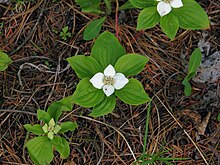Cornus canadensis
| Cornus canadensis | |
|---|---|

| |
| Growing at Elfin Lakes, British Columbia | |
| Scientific classification | |
| Kingdom: | Plantae |
| Clade: | Tracheophytes |
| Clade: | Angiosperms |
| Clade: | Eudicots |
| Clade: | Asterids |
| Order: | Cornales |
| Family: | Cornaceae |
| Genus: | Cornus |
| Subgenus: | Cornus subg. Arctocrania
|
| Species: | C. canadensis
|
| Binomial name | |
| Cornus canadensis | |
Cornus canadensis is a
Description
Cornus canadensis is a slow-growing
Flowers

In late spring to midsummer, white flowers are produced that are 2 cm (25⁄32 inch) in diameter with reflexed
Pollen release
Each flower has highly elastic petals that flip backward, releasing springy filaments that are cocked underneath the petals. The filaments snap upward flinging pollen out of containers hinged to the filaments. The stamens accelerate at a rate of 24,000 m/s2.[7] The motion, which can be triggered by pollinators, takes place in less than half a millisecond. The bunchberry has one of the fastest plant actions found so far requiring a camera capable of shooting 10,000 frames per second to catch the action.[8][9]
Fruit


The drupes are green, globose in shape, turning bright red at maturity in late summer; each fruit is 5 mm in diameter and contains typically one or two ellipsoid-ovoid shaped stones. The fruits come into season in late summer.[10] The large seeds within are somewhat hard and crunchy.
Taxonomy
While distinctive as a species itself, the generic placement of these plants has differed in various botanical treatments. When the genus Cornus is taken broadly, as done here, this species is Cornus canadensis, and is included in the subgenus Arctocrania.[11] However, if Cornus is treated in a narrower sense, excluding this species, it can instead be classified as Chamaepericlymenum canadense or as Cornella canadensis.[12][13]
Where C. canadensis, a forest species, and Cornus suecica, a bog species, grow near each other in their overlapping ranges in Alaska, Labrador, and Greenland, they can hybridize by cross-pollination, producing plants with intermediate characteristics.[14][15]
Distribution and habitat
Its native distribution includes Japan, North Korea, northeastern China (Jilin Province), the Russian Far East, the northern United States, Colorado, New Mexico, Canada and Greenland.[3]
Cornus canadensis is a
Ecology
Birds are the main dispersal agents of the seeds, feeding on the fruit during their fall migration. In Alaska, bunchberry is an important forage plant for mule deer, black-tailed deer and moose, which eat it throughout the growing season.[18]
Uses
It is used as
The fruits are edible raw but have little flavor.[10][4] The pulp does not easily separate from the seeds. The berries can be cooked, strained, and combined with other fruits or used for pudding.[21]
Culture
References
- ^ "Cornus Canadensis". NatureServe Explorer. NatureServe. Retrieved 2018-04-01.[permanent dead link]
- ISBN 978-1405332965.
- ^ a b "Cornus canadensis". Germplasm Resources Information Network. Agricultural Research Service, United States Department of Agriculture.
- ^ OCLC 3541725.
- ^ Murrell, Zack E.; Poindexter, Derick B. (2016). "Cornus canadensis". In Flora of North America Editorial Committee (ed.). Flora of North America North of Mexico (FNA). Vol. 12. New York and Oxford: Oxford University Press – via eFloras.org, Missouri Botanical Garden, St. Louis, MO & Harvard University Herbaria, Cambridge, MA.
- ^ Barrett, Spencer C.; Helenurm, Kaius. 1987. The reproductive biology of boreal forest herbs. I. Breeding systems and pollination. Canadian Journal of Botany. 65: 2036-2046.
- OCLC 190965401.
- S2CID 4412631.
- . Retrieved 20 December 2021.
- ^ a b Lyons, C. P. (1956). Trees, Shrubs and Flowers to Know in Washington (1st ed.). Canada: J. M. Dent & Sons. pp. 111, 196.
- ^ Murrell, Zack E.; Poindexter, Derick B. (2016). "Cornus subg. Arctocrania". In Flora of North America Editorial Committee (ed.). Flora of North America North of Mexico (FNA). Vol. 12. New York and Oxford: Oxford University Press – via eFloras.org, Missouri Botanical Garden, St. Louis, MO & Harvard University Herbaria, Cambridge, MA.
- ^ Eyde, R. H. 1987. The case for keeping Cornus in the broad Linnaean sense. Systematic Botany. 12(4): 505-518.
- ^ Eyde, Richard H. 1988. Comprehending Cornus: puzzles and progress in the systematics of the dogwoods. Botanical Review. 54(3): 233-351.
- ^ Neiland, Bonita J. 1971. The forest-bog complex of southeast Alaska. Vegetatio. 22: 1-64.
- ^ Murrell, Zack E. 1994. Dwarf dogwoods: Intermediacy and the morphological landscape. Systematic Botany 19: 539-556.
- ^ "Cornus canadensis - Plant Finder". www.missouribotanicalgarden.org.
- ^ "Lady Bird Johnson Wildflower Center - The University of Texas at Austin". www.wildflower.org.
- ^ Hanley, Thomas A.; Cates, Rex G.; Van Horne, Beatrice; McKendrick, Jay D. 1987. Forest stand-age related differences in apparent nutritional quality of forage for deer in southeastern Alaska. In: Provenza, Frederick D.; Flinders, Jerran T.; McArthur, E. Durant, compilers. Proceedings--symposium on plant-herbivore interactions; 1985 August 7–9; Snowbird, UT. Gen. Tech. Rep. INT-222. Ogden, UT: U.S. Department of Agriculture, Forest Service, Intermountain Research Station: 9-17.
- ^ "Cornus canadensis". RHS. Retrieved 7 September 2021.
- ISBN 0-8166-1127-0.
- OCLC 244766414.
- ^ "The Wedding Dress, Bridesmaids' Dresses and Page Boys' Uniforms". 2018-05-19.
External links
- Exploding Dogwood Flowers Williams College website describing the work of Joan Edwards and Dwight Whittaker, with videos and animations.
- Cornus canadensis holotype from Louis-Marie Herbarium (Laval University).
- Bunchberry Archived 2010-12-17 at the Wayback Machine, borealforest.org
- Bunchberry, Ontario's Wildflowers

